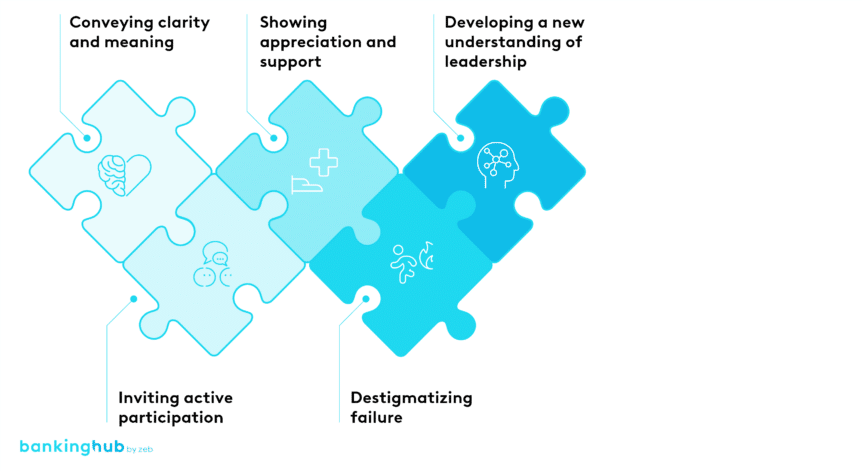Psychological safety – more than just a buzzword
Psychological safety refers to a working environment where employees feel confident to express their ideas, to take risks, to admit mistakes or to ask questions without fear of repercussions.
Popularized by Harvard Business School professor Amy Edmondson, this concept is central to developing high-performing and innovative teams. Extensive research by companies like Google has shown that psychological safety is the single most important factor for innovative, successful and productive work.[1]
Why teams operating without interpersonal fear are more successful
A space free of interpersonal fear allows for open feedback, continuous learning, the ability to change and thus adapt quickly to new circumstances – all essential components of an agile and resilient organization.
In the financial services industry, which is characterized by a high level of regulation, strict demands for accuracy and constant change, it is essential that employees feel safe to express their opinions and discuss creative solutions. Conversely, a climate of fear leads to mistakes, mistrust, and a silo mentality.
BankingHub-Newsletter
Analyses, articles and interviews about trends & innovation in banking delivered right to your inbox every 2-3 weeks
"(Required)" indicates required fields
How managers can specifically promote psychological safety
A psychologically safe environment does not come about by itself. Leaders always have the power to shape the culture of their teams and make psychological safety an integral part of their leadership philosophy. Here are five key areas in which you, as a manager, can take action:
I) Conveying clarity and meaning
- Formulate expectations: Clearly define how the team should handle failure and uncertainty. Explain the importance of all team members speaking up and emphasize that openness, participation and criticism are valued.
- Explain the purpose: Highlight the goals and values pursued by the team. Emphasize the significance of the work for the customer, the company, and stakeholders.
Practical tip: Regularly communicate strategic decisions and the underlying considerations in a short decision briefing. Combine this with your personal expectations for the team’s development to strengthen trust and reduce uncertainty.
II) Inviting active participation
- Be proactive in your inquiry: Ask specific questions, listen actively, and demonstrate genuine interest in your team’s perspectives and ideas. Encourage your team to continuously further develop ideas and thoughts.
- Establish structures: Implement formats for team discussions to ensure that all voices are heard. Develop guidelines and rules for these formats together with the team.
Practical tip: Regularly hold silent meetings where team members first write down their ideas before discussing them together. Use targeted facilitation to ensure that all team members have their say. Give everyone enough time to gather their thoughts and form their opinions.
III) Showing appreciation and support
- Listen and acknowledge: Regularly express appreciation and thanks for the contributions of your team members. Let them know that their ideas and opinions are being taken seriously. Listen sensitively with a focus on the personal relationship aspect and ensure a constructive atmosphere.
- Address violations consistently: Ensure that team agreements are upheld, and respond promptly to any breaches that threaten the culture of psychological safety. Use such situations as opportunities for joint learning as well as for growth and development.
Practical tip: Occasionally start meetings with a short recognition session to highlight positive accomplishments or share success stories. Use the “appreciation shower” format to enable team members to show recognition and appreciation to each other. In the event of rule violations, make it clear that the behavior you have witnessed is undesirable. Then hold a personal discussion with those affected by the rule violations.
IV) Destigmatizing failure
- See mistakes as a learning opportunity: Promote a culture in which failure does not have negative connotations but is seen as an opportunity for growth and development.
- Foster open dialogue about failure: Encourage honest conversations to ease the pressure of perfection and normalize learning from mistakes. Be prepared to talk about your own weaknesses and mistakes to promote a culture of openness.
Practical tip: Once a month, set up a “failure story meeting” where the team can discuss things that have gone wrong in a relaxed atmosphere. Also share your own experiences and talk about mistakes from your professional past. Ensure that everyone understands the key lessons learned, what changes will be made as a result, and the practical insights gained from approaching things differently.
V) Developing a new understanding of leadership
- Set the direction: Develop and communicate a clear direction and invite input from your team to adjust and refine this path.
- Value contributors: View your employees as important contributors with valuable skills, knowledge and insights who actively help shape your success.
Practical tip: Hold regular strategy updates where the team can provide feedback on current developments. Use the “Disney method”, for example. Always remember that your team’s ideas are inspired by skill and combine these ideas with your (strategic) knowledge. Make sure that you and your employees think and formulate simply and clearly, and always put the customer at the center of your considerations.
Psychological safety isn’t achieved through a single effort
By implementing these measures, you will foster an environment where failure is seen not as a weakness, but as an integral part of the continuous learning process within a culture of innovation. These efforts strengthen your organizations’ ability and willingness to change, forming a crucial foundation for sustained high performance.
Keep in mind, however, that creating an environment in which psychological safety thrives is not a one-off exercise, but an ongoing process that often benefits from external support.





